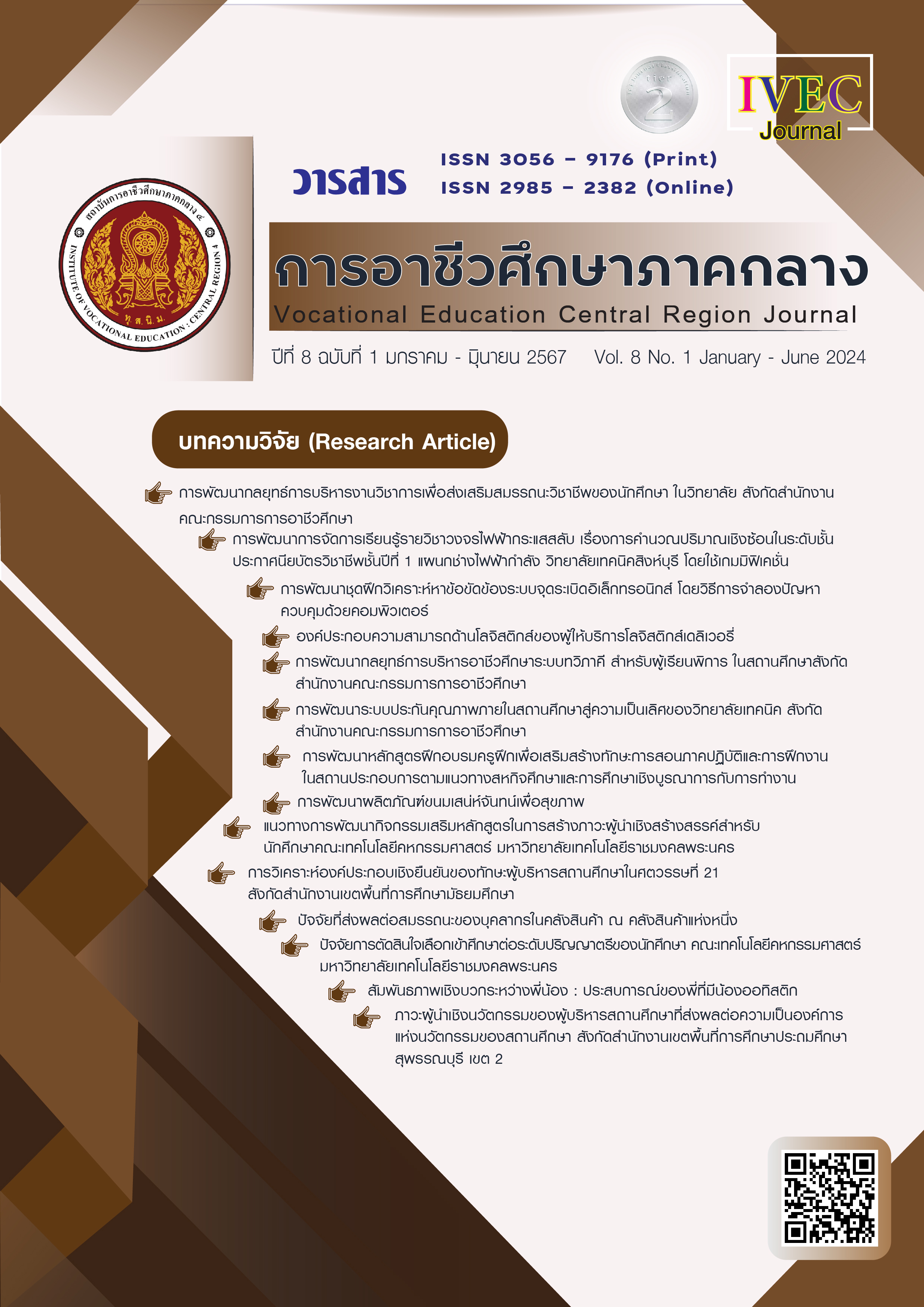Administrative Strategies Development of Dual Vocational Education System for Disabled Students of Educational Institutions under the Office of the Vocational Education Commission
Main Article Content
Abstract
The objectives of this research were to: 1) develop the administrative strategies of dual vocational education system for disabled students; and 2) validate the administrative strategies of dual vocational education system for disabled students. The research used mixed methods and was divided into two phases. Phase 1 focused on developing administrative strategies of dual vocational education system for disabled students. The key informants were educational administration experts, educational institution administrators, teachers, representatives from establishments, and representatives from agencies involved with disabled students, totaling 10 persons, obtained from purposive selection according to the set criteria. Data were collected using a semi-structured interview form and analyzed using content analysis. The research sample was 162 vocational institutions providing education for disabled students, derived by stratified random sampling as distributed by type of educational institution. The questionnaire respondents included 486 directors, deputy directors, and teachers involved with disabled students. Data were collected using a questionnaire and analyzed using frequency, percentage, mean, standard deviation, and priority need index. The strengths, weaknesses, opportunities, and threats were also analyzed using the 2S4M model, PESTEL model, and TOWS matrix. Phase 2 aimed to validate the administrative strategies of dual vocational education system for disabled students. The informants included 9 individuals, comprising senior executives or former senior executives of the Office of the Vocational Education Commission who had worked or had experience working with disabled students or persons with disabilities; vocational education administrators; educational administration experts; teachers or lecturers who had worked with disabled students or persons with disabilities; and experts who were representatives from the establishment with disabled employees. These respondents were purposively selected according to the set criteria. Data were collected through connoisseurship and analyzed using content analysis. The developed strategies were implemented at one vocational institution, selected purposively according to the set criteria. The informants consisted of 5 persons, including the director, the deputy director of academic affairs, and teachers who had worked with disabled students. Data were collected by a feedback meeting and analyzed using content analysis.
The research results revealed that:
- The administrative strategies of the dual vocational education system for disabled students consisted of 5 main strategies: 1) establishing a system to support education funding for disabled students on an equal basis; 2) arranging a system to support educational materials and equipment for disabled students to promote equality in accessing vocational training in the workplace; 3) creating an effective technology system to track and evaluate the vocational training of disabled students; 4) accelerating the adjustment of the service and learning environment system for disabled students; and 5) adjusting the school administrative system to facilitate the provision of dual vocational education for disabled students.
- The administrative strategies of the dual vocational education system for disabled students were found to be accurate, appropriate, practical, and beneficial with consensus. Regarding the results of strategy implementation, it was observed that in Strategy 4 concerning the college arrangements for educational services for disabled students, the college had received comprehensive information from the disabled students, and the students had clear guidelines for accessing the college educational services.
Article Details

This work is licensed under a Creative Commons Attribution-NonCommercial-NoDerivatives 4.0 International License.
|
บทความ ข้อมูล เนื้อหา รูปภาพ ฯลฯ ที่ได้รับการตีพิมพ์ในวารสาร การอาชีวศึกษาภาคกลาง ถือเป็นลิขสิทธิ์ของวารสารการอาชีวศึกษาภาคกลางหากบุคคลหรือหน่วยงานใดต้องการนำทั้งหมดหรือส่วนใดส่วนหนึ่ง ไปเผยแพร่ต่อหรือเพื่อกระทำการใด ๆ กองบรรณาธิการไม่สงวนสิทธิ์ ในการคัดลอกบทความเพื่อการศึกษาแต่ให้อ้างอิงแหล่งที่มาให้ครบถ้วน สมบูรณ์ สงวนสิทธิ์ โดย สถาบันการอาชีวศึกษาภาคกลาง 4 ที่ตั้ง 90 ถนนเทศา ตำบลพระปฐมเจดีย์ อำเภอเมือง จังหวัดนครปฐม โทรศัพท์ 034 242 856 , โทรสาร 034 242 858 ISSN : 3056-9176 (print) ISSN : 2985-2382 (online) |
References
กลุ่มเทคโนโลยีสารสนเทศเพื่อการบริหารงานอาชีวศึกษา ศูนย์เทคโนโลยีสารสนเทศและกำลังคนอาชีวศึกษา. (2564). สรุปข้อมูลรายสถานศึกษาอาชีวศึกษาที่มีผู้เรียนพิการปีการศึกษา 2564. ค้นเมื่อ 7 พฤศจิกายน 2565 จาก สืบค้น จาก http://std2018.vec.go.th
วันชัย มีชาติ. (2559). การบริหารองค์การ (พิมพ์ครั้งที่ 8). กรุงเทพฯ: จุฬาลงกรณ์.
พระราชบัญญัติส่งเสริมและพัฒนาคุณภาพชีวิตคนพิการ พ.ศ. 2550. (2550, 27 กันยายน). ราชกิจจานุเบกษา. เล่ม 124, ตอนที่ 61 ก, หน้า 1-18.
Kaplan, R.S., & Norton, D.P. (2001). The strategy-focused organization. United States: Harvard Business Review Press.
Krejcie, R.V., & Morgan, D.W. (1970). Determiningsample size for research activities. Educational and Psychological Measurement, 30, (3), pp. 607-610.


